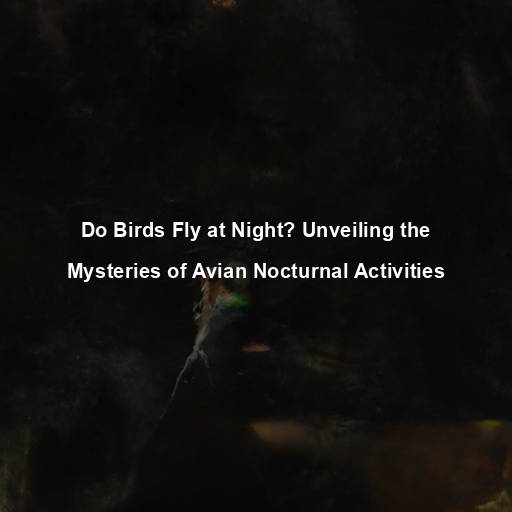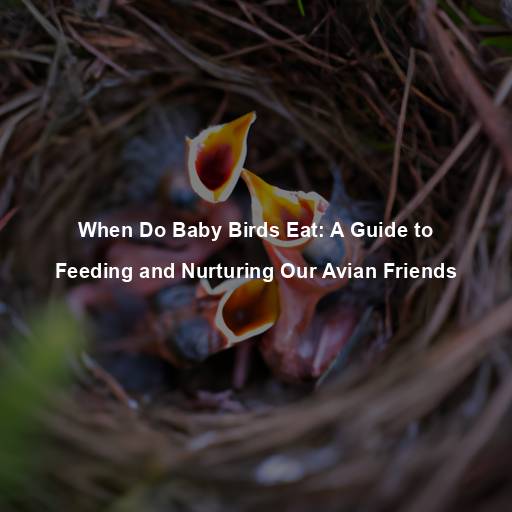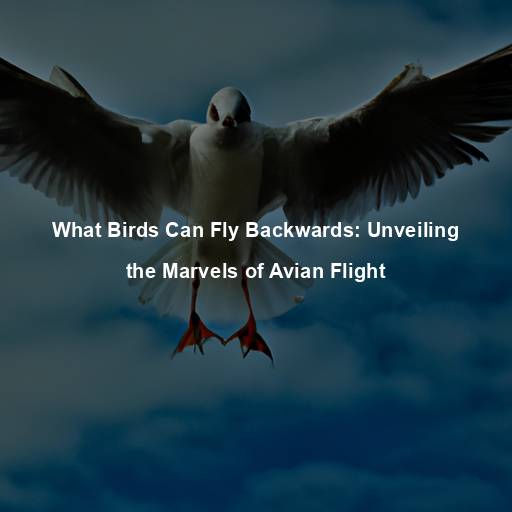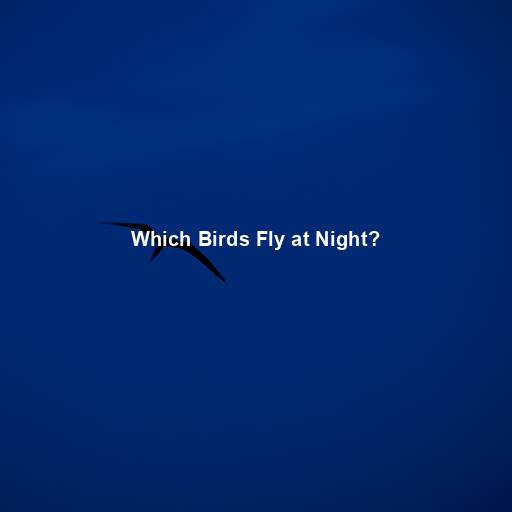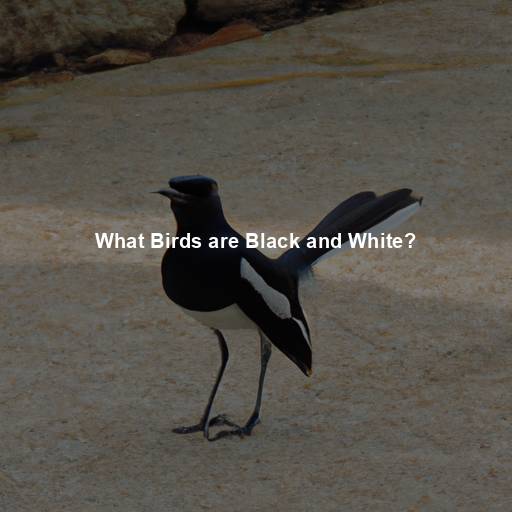Do Birds Fly at Night? Unveiling the Mysteries of Avian Nocturnal Activities
Last Updated on July 30, 2023 by Evan
Contents
- 1 The Fascinating World of Avian Behavior
- 2 Understanding Bird Behavior at Night
- 3 The Science Behind Avian Night Vision
- 4 Unraveling the Mysteries of Bird Migration at Night
- 5 The Myth of Birds Sleeping While Flying
- 6 The Ethereal Beauty of Birds Flying at Night
- 7 Unlocking the Secrets of Avian Nocturnal Activities
- 8 The Cultural Significance of Birds Flying at Night
- 9 Preserving the Nocturnal Habitats of Birds
- 10 The Magic of Birds Flying at Night: A Timeless Wonder
- 11 FAQs: Does Birds Fly at Night?
- 11.1 ### Do all bird species fly at night?
- 11.2 ### What are some examples of nocturnal bird species?
- 11.3 ### Why do some birds fly at night?
- 11.4 ### How do nocturnal birds navigate and find their way in the dark?
- 11.5 ### Are there any risks associated with flying at night for birds?
- 11.6 ### Can diurnal birds fly at night if necessary?
- 11.7 ### Are there any regulations or laws regarding birds flying at night?
The Fascinating World of Avian Behavior
Throughout the ages, our fascination with the mystical avian realm has never waned. Enigmatic and bewitching, birds have bewitched us with their ethereal beauty, enchanting songs, and eloquent aerobatics. But here’s the mind-boggling question that keeps us wide-eyed and restless: do these captivating creatures continue their graceful flights as the sun bids us farewell? Brace yourselves, dear readers, for we shall embark on an audacious journey into the nocturnal realm of avian wanderlust, where moonlit skies bear witness to soaring silhouettes and whispers of mystery fill our curious minds.
Understanding Bird Behavior at Night
Avian Nocturnal Adaptations
Birds, like many other animals, have adapted to their specific environments and lifestyles over millions of years. While some species are diurnal, meaning they are primarily active during the daytime, others have evolved to be crepuscular or nocturnal. Nocturnal birds possess a range of adaptations that enable them to thrive in low-light conditions, including enhanced night vision, acute hearing, and specialized feathers for silent flight.
The Nocturnal Bird Species
A diverse array of bird species are known for their nocturnal behavior. Owls, for instance, are iconic nocturnal birds that have become synonymous with the night. With their large eyes, exceptional hearing, and silent flight, these birds of prey are perfectly suited for hunting in the darkness. Other nocturnal species include nightjars, nighthawks, and certain types of seabirds.
The Purpose of Nighttime Flights
Birds in the darkness of the night embark on a whirlwind of activities, with a mysterious agenda that keeps us pondering their intentions. They gracefully take to the skies, seizing the opportunity of cooler temperatures and minimized rivalry for nourishment, in their relentless pursuit of sustenance. Furthermore, their nocturnal flights seem to be a shrewd tactic to elude predators lurking in the daylight and circumvent any unfavorable circumstances that may arise.
The Science Behind Avian Night Vision
Adaptations for Low-Light Vision
Nocturnal birds have evolved specific adaptations to navigate and hunt in dimly lit environments. One notable adaptation is the presence of a higher density of rod cells in their retinas, which are responsible for detecting light. This abundance of rod cells allows them to gather more available light, enhancing their ability to see in the dark.
Tapetum Lucidum: The Reflective Layer
In the enchanting world of nocturnal birds, an extraordinary adaptation has captured the curiosity of scientists and nature enthusiasts alike – the enigmatic tapetum lucidum. Nestled slyly behind the delicate retina, this mysterious layer possesses an uncanny ability to reflect light, enhancing the avian creature’s quest for the faintest glimmer of illumination. Drawing parallels to the captivating glow emanating from a feline’s eyes in the midst of darkness, this ethereal structure fuels the nocturnal bird’s quest for enhanced night vision, marking yet another wonder in the intricate tapestry of nature’s evolutionary enigmas.
Color Vision Differences
As fascinating as the realm of colors can be for us, it turns out that our avian counterparts have a peculiar way of perceiving the world. While we humans boast three cones in our eyes to capture the enigmatic spectrum of colors, most feathered friends only have a mere two. But don’t be too quick to dismiss their visual capabilities – this adaptation actually equips them with a remarkable advantage in dimly lit environments. By sacrificing their ability to see the full spectrum of hues, birds gain an uncanny knack for deciphering subtle variations in brightness, a skill that proves paramount when navigating the dark abyss of night.
Unraveling the Mysteries of Bird Migration at Night
The Marvels of Nocturnal Migration
Bird migration is a fascinating spectacle that leaves scientists and nature enthusiasts in awe. This natural phenomenon, observed in various bird species, involves epic long-distance journeys that span thousands of miles. While daylight migration has been extensively studied, recent research has unveiled the bewildering world of nocturnal migration, shining a light on the hidden secrets of avian travel. Astonishingly, billions of birds take to the skies under the cloak of darkness, using the cover of night to embark on their extraordinary expeditions, uninterrupted by human interference.
The enigmatic navigation skills possessed by birds during their nighttime migrations have left researchers scratching their heads for years. Although the complete workings of this avian GPS system remain elusive, scientists have made headway in unraveling the mysterious cues that guide these feathered travelers. From the celestial secrets of stars and moonlight to the earthly whispers of landmarks and magnetic forces, these nocturnal migrants intricately combine an uncharted blend of cues to achieve their awe-inspiring navigational precision.
The Importance of Conservation
Bird migration is a captivating enigma that demands our attention. The fate of these magnificent avian travelers hangs precariously in the balance, as they navigate complex diurnal and nocturnal journeys. Their path ahead is fraught with danger, from diminishing habitats to the looming specter of climate change, not to mention the unfortunate encounters with man-made structures. Unveiling the secrets of their behavior and migration patterns is not only a scientific pursuit but also a call to arms for preserving the awe-inspiring wonders of the feathered world.
The Myth of Birds Sleeping While Flying
Debunking a Common Misconception
There’s this widely held belief that birds can catch some snooze mid-air. But here’s the thing – they don’t sleep like us humans do. Nope, they’ve got this mind-boggling trick up their feathers called “unihemispheric slow-wave sleep” – essentially, they rest one side of their brain while keeping the other side awake and alert. It’s a clever adaptation that lets them stay vigilant during flight, ready to respond to any dang danger that might come their way.
The Power of Power Naps
As creatures of the night, nocturnal birds have a captivating way of resting that may leave us scratching our heads. Unlike their daytime counterparts, these feathered friends don’t doze off while soaring through the skies. Instead, they opt for something a bit more unconventional – quick bursts of power naps mid-flight. These puzzling moments of reprieve serve a vital purpose, allowing them to save energy and stay vigilant as they navigate the moonlit landscape.
Roosting and Sleep
When birds are not actively engaged in flight or foraging, they seek out safe roosting spots to rest and sleep. These roosting sites can vary depending on the species and may include trees, shrubs, cliffs, or even man-made structures. Roosting provides birds with a secure place to rest and recover, away from potential predators.
The Ethereal Beauty of Birds Flying at Night
A Nighttime Symphony
One of the most captivating aspects of birds flying at night is the ethereal beauty of their songs. While some birds, like owls, are famously known for their haunting hoots, many other species fill the night with a symphony of calls and melodies. These nocturnal serenades add a magical touch to the darkness and remind us of the incredible diversity of avian vocalizations.
Witnessing Nighttime Migrations
For those fortunate enough to witness nocturnal bird migration, it is an awe-inspiring experience. As birds traverse the night sky in large flocks, their silhouettes against the moonlit backdrop create a mesmerizing spectacle. This phenomenon offers a glimpse into the hidden world of avian nocturnal activities and serves as a testament to the wonders of nature.
The Connection Between Birds and the Night
Throughout history, birds have held a captivating and mystifying allure when it comes to their nocturnal adventures. From the timeless tales of folklore to the pages of modern literature, these fascinating creatures have sparked the imagination of humanity. Their ethereal flights under the cover of darkness leave us in awe, beckoning us to explore the enigmatic realm that lies beyond our daylight existence, reminding us of the interconnectedness that we often overlook.
Unlocking the Secrets of Avian Nocturnal Activities
Ongoing Research and Discoveries
Despite our growing understanding of avian behavior, there is still much to learn about the intricacies of birds flying at night. Ongoing research and technological advancements, such as the use of radar and acoustic monitoring, are providing scientists with valuable insights into the nocturnal lives of our feathered friends. Each new discovery brings us closer to unraveling the secrets of their nighttime activities.
Citizen Science and Birdwatching
Citizen science initiatives and birdwatching enthusiasts play a vital role in expanding our knowledge of avian nocturnal activities. By sharing their observations and contributing to data collection efforts, these individuals help researchers gain a broader understanding of bird behavior and migration patterns. Their passion and dedication make a significant impact on scientific endeavors.
Cultivating a Sense of Wonder
In a world that often seems consumed by the hustle and bustle of daily life, taking a moment to appreciate the wonders of the natural world can be profoundly rewarding. Birds flying at night serve as a reminder of the beauty and mystery that surrounds us. By cultivating a sense of wonder and curiosity, we can forge a deeper connection with the avian world and foster a greater appreciation for the delicate balance of our planet.
The Role of Nocturnal Birds in Ecosystems
The enigmatic dance of the nocturnal avian creatures holds the key to the intricate web of life that envelops our ecosystems. Their graceful flight under the cover of darkness bolsters the delicate fabric of nature, ensuring the harmonious interplay of every living being. From the vital act of pollination to the essential task of seed dispersal, these elusive birds play a perplexing role in nurturing the tapestry of life, while simultaneously curbing the population of pesky nocturnal insects. Through their enigmatic forays, they offer us a tantalizing glimpse into the mysterious mechanisms that sustain biodiversity.
The Secret Lives of Nocturnal Pollinators
When we think of pollination, we tend to picture buzzing bees and fluttering butterflies under the sun’s warm embrace. However, the secret pollinators of the night, such as nectar-loving bats and tiny hummingbirds, have their own captivating tale to tell. With their long beaks and specialized tongues, these enchanting creatures have navigated the dark to forge intimate relationships with nocturnal flowers. Their mysterious dance in the moonlight ensures the continuation of countless plant species, painting a mesmerizing tapestry of life’s interconnections.
Seed Dispersal Under the Moonlight
Birds that engage in nocturnal flight are also crucial for seed dispersal. As they consume fruits and berries during their nighttime foraging, they inadvertently transport seeds to new locations. This dispersal mechanism allows plants to colonize new areas, contributing to biodiversity and ecosystem resilience.
Controlling Nocturnal Insect Populations
Birds that are active at night play a vital role in controlling nocturnal insect populations. They feed on a variety of insects, including moths, beetles, and mosquitoes, helping to keep their numbers in check. By regulating insect populations, these birds help maintain the ecological balance and reduce the impact of pests on crops and human settlements.
The Cultural Significance of Birds Flying at Night
Birds in Folklore and Mythology
Throughout human history, birds flying at night have held a special place in folklore and mythology. In many cultures, these nocturnal flights are associated with mystical and supernatural elements. They are often seen as messengers of the gods, symbols of wisdom, or omens of good or bad luck. The enigmatic nature of birds flying under the moonlight has inspired countless legends and stories across different civilizations.
Birds as Symbols of Transformation
The nocturnal flights of birds have also been interpreted as symbols of transformation and rebirth. Their ability to navigate through the darkness and emerge unscathed has made them powerful metaphors for overcoming challenges and embracing change. In literature and art, birds in flight often represent freedom, transcendence, and the human desire to soar beyond limitations.
Birdwatching and Nocturnal Birding
Explore the mesmerizing world of nocturnal birding, where passionate nature lovers delve into the enigmatic realm of avian creatures that come alive under the blanket of darkness. As the sun sets, a newfound adventure begins, offering an unrivaled and exhilarating encounter with these mysterious winged wonders. Equipped with state-of-the-art tools like night-vision binoculars and cutting-edge audio recording devices, birdwatchers embrace the challenge of capturing elusive behaviors and deciphering the intricate melodies of these nocturnal species. Step into the shadows and unlock the secrets of the night sky, as the captivating universe of nocturnal birding unveils itself to the fervent explorer.
Preserving the Nocturnal Habitats of Birds
The Threats to Nocturnal Birds
As human activities continue to encroach upon natural habitats, nocturnal birds face numerous threats to their survival. Habitat loss, light pollution, and climate change are among the significant challenges that these birds must contend with. The disruption of their nocturnal environments can affect their foraging, roosting, and breeding patterns, ultimately impacting their population dynamics.
Mitigating Light Pollution
Excessive artificial lighting, like an unruly burst of fireworks, casts a perplexing net of light pollution across the skyline, leaving nocturnal birds in a state of disorientation. Their innate ability to navigate the darkness is disrupted, much like a compass going haywire in a magnetic storm. Furthermore, this intrusive illumination plays havoc with their foraging routines, scattering their prey and turning a simple hunt into a complex maze. To combat this perplexing predicament, a collective effort has blossomed, like a field of bright stars, to promote responsible lighting practices and cultivate a newfound appreciation for the precious darkness that embraces our night sky.
Conservation and Habitat Restoration
Protecting the habitats of nocturnal birds is of utmost importance, as these incredible creatures rely on undisturbed environments for their survival. This entails not only preserving the natural habitats where these birds thrive, but also putting efforts into restoring degraded areas and creating safe passageways for them to navigate fragmented landscapes. By diligently safeguarding these nocturnal ecosystems, we can guarantee the longevity and prosperity of these awe-inspiring avian species.
The Magic of Birds Flying at Night: A Timeless Wonder
Inspiration from the Nocturnal Skies
There’s an inexplicable allure in witnessing birds gracefully ascend into the starlit expanse of the sky. It’s a magical spectacle that stirs something within us, reminding us of the boundless wonders of the natural world and the intricate threads that bind us to it. Against the backdrop of moonlight, their delicate dance and the harmonious melodies they create intoxicate our senses, leaving us in awe of the enchanting realm that birds effortlessly inhabit.
A Call to Protect and Celebrate Nocturnal Birds
As we delve into the mysteries of birds flying at night, let us also recognize our responsibility to protect and celebrate these extraordinary creatures. By conserving their habitats, raising awareness about their importance, and embracing sustainable practices, we can ensure that future generations will continue to be enchanted by the magic of avian nocturnal flight.
Embracing the Enigma of the Night
In our fast-paced and ordered existence, the captivating mystery of birds soaring through the night sky breaks free from the mundane. Their nocturnal journeys remind us that there is still so much left unexplored, beckoning us to step out of our diurnal routines and venture into the enigmatic realms of the unknown. As we gaze up at the celestial canvas illuminated by twinkling stars, let the sight of these daring aviators captivate our senses and instill in us an overwhelming wonder for the vast and intricate tapestry of life that lies beyond our daily perception. It is in these moments of sublime nocturnal encounters that we can truly grasp the extraordinary wonders of our shared world.
FAQs: Does Birds Fly at Night?
### Do all bird species fly at night?
No, not all bird species fly at night. While many bird species are diurnal, meaning they are active during the day, there are also nocturnal bird species that are adapted to flying at night. These nocturnal birds have special adaptations such as enhanced night vision and acute hearing to navigate and hunt in low-light conditions.
### What are some examples of nocturnal bird species?
Some common examples of nocturnal birds include owls, nightjars, and nighthawks. Owls are well-known nocturnal birds, with their silent flight and exceptional vision in the dark. Nightjars and nighthawks are also nocturnal and are known for their agile flight and feeding habits, often catching insects on the wing during the night.
### Why do some birds fly at night?
When the moon casts its ethereal glow upon the world, an extraordinary phenomenon unfolds. Birds take flight, defying the constraints of daylight and embracing the bewitching realm of the night sky. Why, you may wonder, do these avian creatures embark on such enigmatic expeditions under the cloak of darkness? The answer lies in a tapestry of reasons intricately woven with the strands of survival and opportunity. For these nocturnal voyagers, the cover of night grants them the upper hand in the art of hunting. With the absence of their diurnal rivals, these avian predators can relish in a cornucopia of late-night delicacies, from elusive nocturnal insects to unsuspecting rodents and even their fellow feathered friends. But it is not merely sustenance that propels them into the inky abyss; it is also an escape from the scorching heat that plagues the daytime realm or the bone-chilling cold of certain regions. So, when you gaze at the night sky and catch a glimpse of these mysterious birds, know that they have mastered the delicate dance between survival and adaptability, navigating the enigma of nocturnal flight.
The enchanting world of nocturnal birds fascinates researchers and nature enthusiasts alike, as these feathered creatures gracefully navigate the darkness using intriguing strategies. Through their acute hearing, they skillfully detect sounds that guide them to prey and facilitate communication with their fellow nocturnal counterparts. The captivating owls, with their remarkable night vision capabilities, owe their exceptional sight to unique eye adaptations which amplify their ability to see in dimly lit surroundings. Beyond this, some of these mysterious birds rely on celestial cues, stars scattered across the canopy, or even the Earth’s magnetic field, to masterfully navigate their evening flights with unwavering precision.
### Are there any risks associated with flying at night for birds?
When the moon hangs heavy in the sky, our feathered friends embark on an enigmatic journey fraught with peril. The cloak of darkness that shrouds the night can transform their flight into a treacherous ballet, as they desperately navigate a world aglow with man-made luminosity. The dazzling lights of our urban landscapes bewilder and bewitch winged souls, often resulting in tragic collisions that extinguish their vibrant existence. As if beset by invisible hounds, these nocturnal creatures must also contend with cunning predators who prowl under the cover of darkness. Yet, against all odds, these resilient avian beings have honed their instincts, unfurling a tapestry of adaptations and behaviors that offer a glimmering ray of hope in their quest for survival.
### Can diurnal birds fly at night if necessary?
Diurnal birds, typically lively in the daytime, may find themselves navigating the mysterious night skies under extraordinary circumstances. Reasons for their nocturnal adventures may encompass impromptu migrations, fleeing from lurking predators, or seeking sustenance when resources prove scarce. Nevertheless, it is critical to note that their twilight expeditions are not their customary domain, as they lack the distinctive adaptations possessed by their nocturnal counterparts for seamless nighttime flight.
### Are there any regulations or laws regarding birds flying at night?
There are no specific regulations or laws regarding birds flying at night. Birds, both diurnal and nocturnal, are free to fly whenever they need or prefer, in accordance with their natural behavior. However, it is essential for humans to be mindful of the impact of artificial lights on nocturnal birds and to make efforts to reduce light pollution, especially in areas with significant bird populations or migratory routes, to avoid detrimental effects on their behavior and survival.

